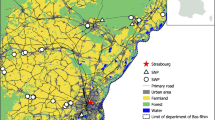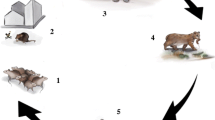Abstract
The primary ecological impact of invasive cane toads (Rhinella marina) in Australia is mediated by their powerful toxins, which are fatal to many native species. Toads use roads as invasion corridors and feeding sites, resulting in frequent road-kills. The flattened, desiccated toad carcasses remain highly toxic despite being heated daily to >40°C for many months during the tropical dry-season. In controlled laboratory experiments, native tadpoles (Cyclorana australis, Litoria rothii), fishes (Mogurnda mogurnda) and leeches (Family Erpobdellidae) died rapidly when we added fragments of sun-dried toad to their water, even if the native animals had no physical access to the carcass. Given the opportunity, native tadpoles and fishes strongly avoided the vicinity of dried toad fragments. Hence, long-dead toads may contaminate roadside ponds formed by early wet-season rains and induce avoidance and/or mortality of native anuran larvae, fishes and invertebrates. Our studies show that the toxicity of this invasive species does not end with the toad’s death, and that methods for disposing of toad carcasses (e.g., after culling operations) need to recognize the persistent danger posed by those carcasses.





Similar content being viewed by others
References
Backyard Poultry (2008) Unexplained death. Available from http://forum.backyardpoultry.com/viewtopic.php?f=5&t=7965992&p=183661&hilit=cane+toad#p183661. Accessed July 2009
Beckmann C (2010) Interactions between cane toads and Australian birds. Dissertation, University of Sydney
Beckmann C, Shine R (2010) The power of myth: the (non) impact of invasive cane toads (Bufo marinus) on domestic chickens (Gallus gallus). Anim Prod Sci 50:847–851
Beckmann C, Shine R (2011) Toad’s tongue for breakfast: exploitation of a novel prey type, the invasive cane toad, by scavenging raptors in tropical Australia. Biol Invasions 13:1447–1455
Brown GP, Phillips BL, Webb JK, Shine R (2006) Toad on the road: use of roads as dispersal corridors by cane toads (Bufo marinus) at an invasion front in tropical Australia. Biol Conserv 133:88–94
Capon RJ, Hayes RA, Piggott AM (2009) Myth busting—cane toads in Australia. Chem Aust 76:3–6
Commonwealth (2007) Parliamentary Debates, House of Representatives, 25 October 2007, #6823: Mrs C. Martin, Member for Kimberley, Grievance—Cane toads. http://www.parliament.wa.gov.au/Hansard%5Chansard.nsf/0/f3ad0287968f2973c8257570007f7ada/$FILE/A37%20S1%2020071025%20p6823b-6826a.pdf. Accessed 30 Aug 2010
Crossland MR, Azevedo-Ramos C (1999) Effects of Bufo (Anura: Bufonidae) toxins on tadpoles from native and exotic Bufo habitats. Herpetologica 55:192–199
Crossland MR, Shine R (2010) Vulnerability of an Australian anuran tadpole assemblage to the toxic eggs of the invasive cane toad (Bufo marinus). Austral Ecol 35:197–203
DeVault TL, Rhodes OE Jr, Shivik JA (2003) Scavenging by vertebrates: behavioral, ecological, and evolutionary perspectives on an important energy transfer pathway in terrestrial ecosystems. Oikos 102:225–234
Doody JS, Green B, Sims R, Rhind D, West P, Steer D (2006) Indirect impacts of invasive cane toads (Bufo marinus) on nest predation in pig-nosed turtles (Carettochelys insculpta). Wildl Res 33:349–354
Foster R, Smith M (2009) First aid for toad poisoning in pets. http://www.peteducation.com/article.cfm?c=2+1677+1681&aid=2394. Accessed July 2009
Frog Decline Reversal Project (2009) The unwanted amphibian. http://www.fdrproject.org.au/pages/toads.htm. Accessed July 2009
Frogwatch NT (2010) Frequently asked questions. http://www.frogwatch.org.au/index.cfm?fuseaction=viewQuestion&question_id=861. Accessed Sept 2010
Gosner KL (1960) A simplified table for staging anuran embryos and larvae with notes on identification. Herpetologica 16:183–190
Grace B (2008) Cane toads and Top End fish. Fishnote No. 42. Department of Primary Industry, Fisheries and Mines, Darwin, NT
Gressitt JL (1952) Descriptions of Kayangel Atoll, Palau Islands. Atoll Res Bull 14:1–13
Griffiths AD, McKay JL (2007) Cane toads reduce the abundance and site occupancy of Merten’s water monitor (Varanus mertensi). Wildl Res 34:609–615
Hayes RA, Crossland MR, Hagman M, Capon RJ, Shine R (2009a) Ontogenetic variation in the chemical defenses of cane toads (Bufo marinus): toxin profiles and effects on predators. J Chem Ecol 35:391–399
Hayes RA, Piggott AM, Dalle K, Capon RJ (2009b) Microbial biotransformation as a source of chemical diversity in cane toad steroid toxins. Bioorg Med Chem Lett 19:1790–1792
Janzen DH (1977) Why fruits rot, seeds mold, and meat spoils. Am Nat 111:691–713
Jofre MB, Karasov WH (1999) Direct effects of ammonia on three species of North American anuran amphibians. Environ Toxicol Chem 18:1806–1812
Kimberley Toad Busters (2010) Training and safety manual. http://www.canetoads.com.au/Training%20and%20Safety%20Manual.htm. Accessed Sept 2010
Letnic M, Webb JK, Shine R (2008) Invasive cane toads (Bufo marinus) cause mass mortality of freshwater crocodiles (Crocodylus johnstoni) in tropical Australia. Biol Conserv 141:1773–1782
Lever C (2001) The cane toad. The history and ecology of a successful colonist. Westbury Scientific Publishing, Otley
Lewis S (1989) Cane toads: an unnatural history. Dolphin/Doubleday, New York
Lim TH, Leitch IM, Boura ALA, Read MA, Walters WAW (1997) Effects of Bufo marinus skin toxins on human fetal extracorporeal blood vessels. Toxicon 35:293–304
Mack RN, Simberloff D, Lonsdale WM, Evans H, Clout M, Bazzaz FA (2000) Biotic invasions: causes, epidemiology, global consequences, and control. Ecol Appl 10:689–710
Madsen T, Shine R (1994) Toxicity of a tropical Australian frog, Litoria dahlii, to sympatric snakes. Wildl Res 21:21–25
Manteifel YB (2006) Tadpoles of the Grass frog (Rana temporaria) and Moor frog (Rana arvalis) avoid zones with elevated ammonia concentration. Doklady Biol Sci 411:458–460
O’Donnell S, Webb JK, Shine R (2010) Conditioned taste aversion enhances the survival of an endangered predator imperiled by a toxic invader. J Appl Ecol 47:558–565
Parker IM, Simberloff D, Lonsdale WM, Goodell K, Wonham M, Kareiva PM, Williamson MH, Von Holle B, Moyle PB, Byers JE, Goldwasser L (1999) Impact: toward a framework for understanding the ecological effects of invaders. Biol Invasions 1:3–19
Phillips BL, Shine R (2007) When dinner is dangerous: toxic frogs elicit species-specific responses from a generalist snake predator. Am Nat 170:936–942
Phillips BL, Greenlees MJ, Brown GP, Shine R (2010) Predator behaviour and morphology mediates the impact of an invasive species: cane toads and death adders in Australia. Anim Conserv 13:53–59
Pramuk JB (2006) Phylogeny of South American Bufo (Anura: Bufonidae) inferred from combined evidence. Zool J Linn Soc 146:407–452
Rayward A (1974) Giant toads—a threat to Australia’s wildlife. Wildlife 17:506–507
Scott-Virtue L (2009) Kimberly Toad Busters. Kimberly Toad Busters, Kununurra, Western Australia. http://www.canetoads.com.au. Accessed July 2009
Shine R (2010) The ecological impact of invasive cane toads (Bufo marinus) in Australia. Q Rev Biol 85:253–291
Shine R, Brown GP (2008) Adapting to the unpredictable: reproductive biology of vertebrates in the Australian wet-dry tropics. Philos Trans R Soc B 363:363–373
Snyder WE, Evans EW (2006) Ecological effects of invasive arthropod generalist predators. Annu Rev Ecol Evol Syst 37:95–122
Stop The Toad Foundation (2008) Great toad muster report. http://www.stopthetoad.org.au/publications/Muster2008Report.pdf. Accessed Sept 2010
Stop The Toad Foundation (2010) Volunteer induction manual. http://www.stopthetoad.org.au/publications/volunteer_induction_manual2010.pdf. Accessed Sept 2010
Tyler MJ (1975) The cane toad Bufo marinus: an historical account and modern assessment. The Vermin and Noxious Weeds Destruction Board, Victoria and Agriculture Protection Board, Western Australia
Urban MC, Phillips BL, Skelly DK, Shine R (2007) The cane toad’s (Chaunus marinus) increasing ability to invade Australia is revealed by a dynamically updated range model. Proc R Soc B 274:1413–1419
Webb JK, Brown GP, Child T, Greenlees MJ, Phillips BL, Shine R (2008) A native dasyurid predator (common planigale, Planigale maculata) rapidly learns to avoid a toxic invader. Austral Ecol 33:821–829
White EM, Wilson JC, Clarke AR (2006) Biotic indirect effects: a neglected concept in invasions biology. Divers Distrib 12:443–455
Woldendorp G, Keenan RJ (2005) Coarse woody debris in Australian forest ecosystems: a review. Austral Ecol 30:834–843
Acknowledgments
We thank C. Kelehear and C. Glasby for assistance with leech identification, and Rob Capon for insights into toad toxins. Animals were collected under Northern Territory Parks and Wildlife Commission Permit 32289. The work was approved by the University of Sydney Animal Ethics Committee (Approval Number L04/5-2007/3/4494) and funded by the Australian Research Council.
Author information
Authors and Affiliations
Corresponding author
Rights and permissions
About this article
Cite this article
Crossland, M., Brown, G. & Shine, R. The enduring toxicity of road-killed cane toads (Rhinella marina). Biol Invasions 13, 2135–2145 (2011). https://doi.org/10.1007/s10530-011-0031-x
Received:
Accepted:
Published:
Issue Date:
DOI: https://doi.org/10.1007/s10530-011-0031-x




